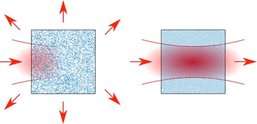Dense yet transparent materials offer new way to control light

Researchers recently made the surprising discovery that a special class of materials called "hyperuniform materials" can be both dense and transparent. This work demonstrates a new way to control light and could lead to novel materials for many light-based applications including solar photovoltaics. These so-called "hyperuniform materials" can be made of plastic or glass that contains light-scattering particles spaced in a disordered, but not completely random, pattern.
In The Optical Society's journal for high impact research, Optica, researchers led by Rémi Carminati, Institut Langevin, ESPCI Paris and CNRS, France, detail the transparency properties they discovered using computer simulations and outline a theory to explain the wavelengths of light for which hyperuniform materials appear transparent.
"We showed that hyperuniform materials can be transparent for certain wavelengths while at the same time being very dense," said Carminati. "Although our work is conceptual, we have found something very new."
Optical properties of hyperuniform materials
Although hyperuniform materials have been studied for the last decade, their optical properties are only recently being uncovered. Researchers previously showed that a hyperuniform material is transparent when it has a particle density that allows light going through the material to interact with each particle no more than once.
"Typically if you make a material denser, it will scatter light more and thus appear opaque," said Carminati. "However, what we've shown is that if you make the hyperuniform material denser to the point where light will interact with many particles on its way through the material, you can still observe transparency. This is really unexpected, and nobody has examined it before."
This surprising characteristic of dense hyperuniform materials occurs because of the microscopic-scale ordering of the particles in the material. Although the uniformly spaced particles scatter light in all directions, most of the light waves interfere with each other, stopping all the scattered light except for light traveling in the forward direction through the material. This means that the light entering the material continues in the forward direction as if it were going through a homogeneous material, making the material appear transparent. The wavelengths of light for which the material is transparent depend on the exact characteristics of the material used.
The dense hyperuniform materials are highly ordered at a microscopic scale (of about 1 micron for applications in photonics), but remain disordered at a larger scale. This property makes the materials less prone to fabrication errors, which means they could be made in large pieces. Commercial techniques such as lithography could be used to make a hyperuniform material like the one simulated in this study, but Carminati says that developing a fabrication technique that produces hyperuniformity in a natural way could allow manufacturing of such materials in large quantities.
Controlling light waves
"When light waves interact with a material, the scattering that typically occurs destroys many interesting properties of the waves," said Carminati. "Our work shows that it is possible to use the material itself to control the way the waves propagate. This is a big paradigm change. Producing specific materials that are transparent for a spectral region for which you don't expect the material to be transparent is just one example of what can be done."
Carminati points out that while applications for these dense, transparent materials are a long way off, the new study shows the potential for making materials that offer a variety of optical properties. For example, a material could be made to change from randomly spaced particles to perfectly spaced particles in response to an external electric field, thus switching from appearing white to being transparent.
Hyperuniform materials might also be useful for photovoltaics because they offer a way to manipulate how diffuse light enters a material and is absorbed by the particles. Tuning the material so that it is very absorbent across a wide variety of wavelengths could be used to convert light into energy.
Since light waves behave much like acoustic and quantum waves, materials that are dense and transparent could, in principle, be designed for other types of waves. "What we have demonstrated is not specific to optics," said Carminati. "It likely applies to wave physics in general and could open up new applications in other fields."
More information: O. Leseur, R. Pierrat, R. Carminati, "High-density hyperuniform materials can be transparent," Optica, 3, 7, 376 (2016). DOI: 10.1364/optica.3.000763
Journal information: Optica
Provided by Optical Society of America





















